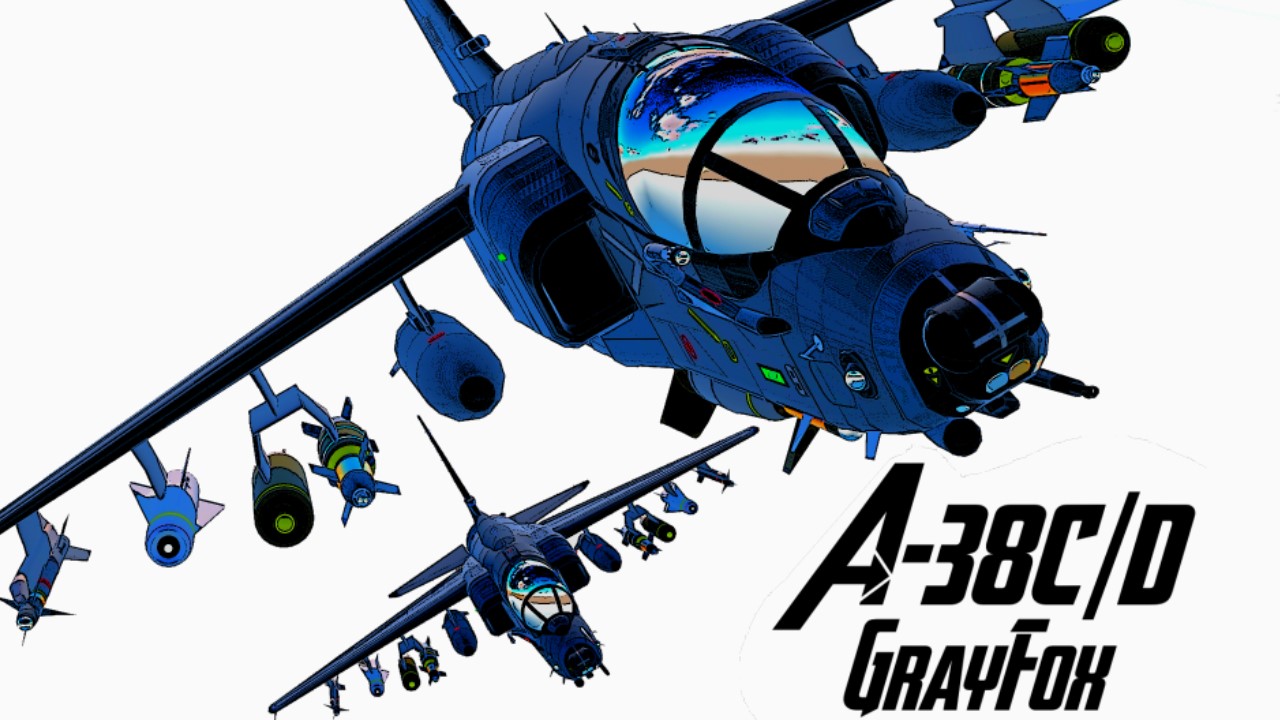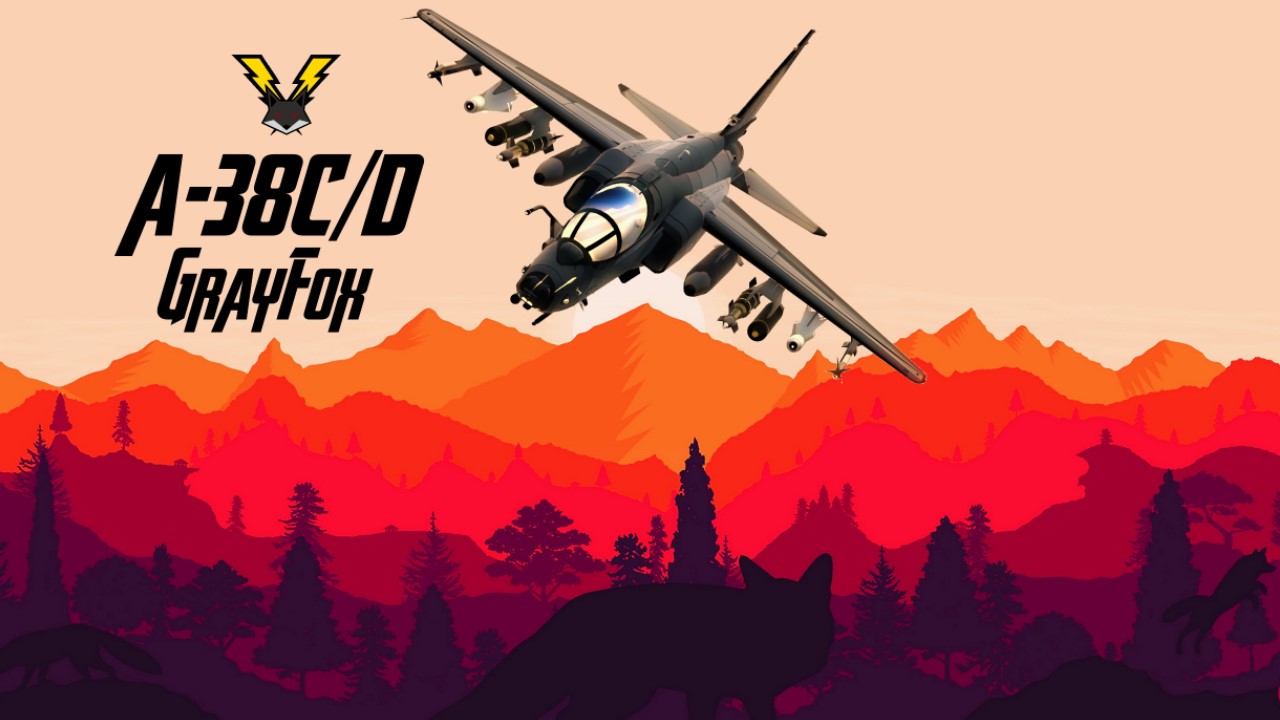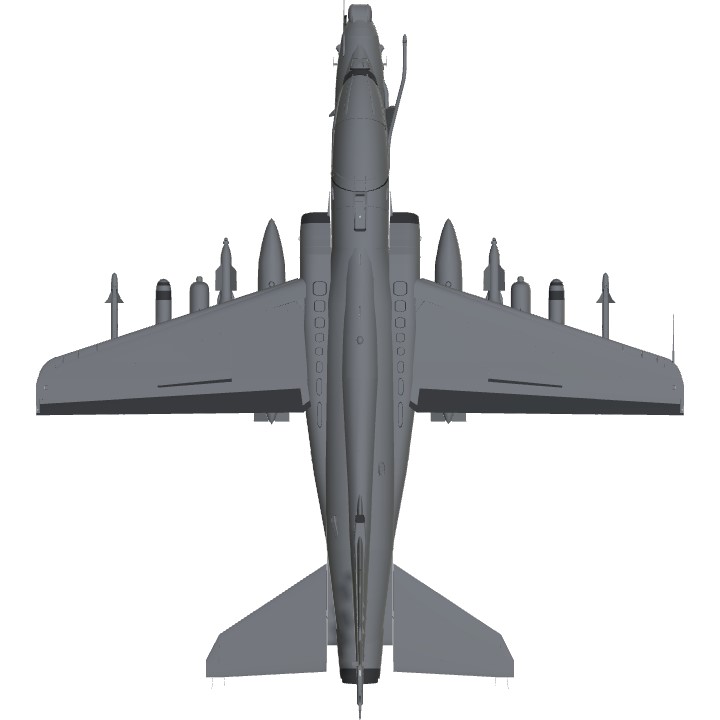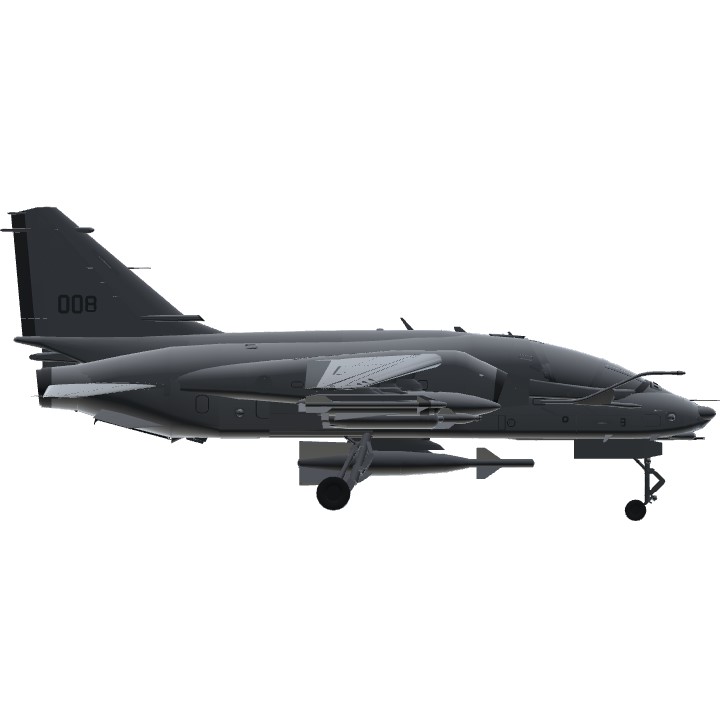This aircraft variant belongs to Royal Thai Air Force/231st Attack Sqn

1) CONTROLS
• AG1: Ventral Speedbrake activation
• AG2: Drag parachute deployment
• AG3: Wing Droptanks Jettison
• AG4: Gyro-stabilized Autopilot System activation
• AG5: Centerline Stores Jettison
• AG6: Formation lights – NIGHT MODE Activation
• AG7: Arresting Hook extension
• VTOL DOWN: Flaps
• TRIM: Normal operation (Tab-Down for Pitch-Up) USE IT ALWAYS
NOTE 1: Speedbrake [AG1] is automatically retracted when Gear Down, IAS < 200kts and 100% Throttle is applied and automatically deployed when TAS > 600kts for overspeed protection
NOTE 2: FLAPS are manually controlled but automatically limited for optimal efficiency depending on aircraft configuration, weight and airspeed.
NOTE 3: Although the aircraft is NOT carrier-based, it has been successfully tested for carrier deck operations. Remember to jettison/fire the centerline loads *[AG5] and extend arresting hook [AG7] before landing on the carrier deck. Proceed at your own risk while executing a carrier landing approach procedure.*
IMPORTANT NOTE: This plane has been built using a series of complicated and inter-structural Funky Trees™ codes for realistic handling behavior and has been thoroughly flight-tested using a Saitek P2600 Rumble Force Gamepad for detailed controlling and it is highly encouraged to use a gamepad, joystick or mouse-as-joystick mode for flying it.
Here is the complete detailed list of Funky Trees™ codes and functions used with explanation for each one of it.
All FT codes are mainly used for stall protection, low-speed handling enhancement, landing approach assist, configuration control and external stores management.
2) T/O INSTRUCTION
• VTOL: 1 TAB DOWN – (HALF) for T/O Flaps
• TRIM: 1 TAB DOWN – (HALF) for T/O SET
• THROTTLE: 100%
NOTE: During T/O roll make small heading adjustments with yaw inputs. Above 60kts IAS/GS Nose Wheel Steering is automatically disengaged for safety reasons.
• Rotate aircraft at 135kts IAS (fully loaded configuration)
• Crossing 400ft - GEAR UP
• VTOL: RESET - MIDDLE for Flaps in UP position
• TRIM: Adjust slightly below MIDDLE to maintain climbing attitude 15-20° nose-up
• THROTTLE: Adjust for cruising flight @ 300-330kts TAS
• Continue Flight

3) LANDING INSTRUCTIONS
• Reduce Airspeed at 250kts IAS and below
• Align with Runway at 1.500 ft Altitude and 2NM distance
• AG1: Activate for Air-brake extension
• GEAR DOWN for LDG extension
• THROTTLE: 15-30% (depends on weight)
--- (OPTIONAL) AG4: Activate for Gyro-stabilization ---
• TRIM: Adjust for 1°-5° Nose Up
• Establish reasonable Rate of Descent (4-5 m/s)
• Maintain Airspeed 110-135kts IAS (depends on weight)
• Make corrections using small THROTTLE and TRIM movements (~1-3%)
NOTE: When turning with LDG in EXTENDED position use THROTTLE 35-45% to compensate for Drag and Lift loss
• Maintain Attitude 1°-5° Nose Up (Optimal AoA Approach)
• 20ft before Touchdown apply Flare technique and use aerodynamic breaking (keep the nose high)
• At Touchdown: THROTTLE – 0% and AG2 for Drag Chute (if needed)
• When all wheels on ground and airspeed below 90kts IAS - APPLY FULL BRAKES
• At speed below 25kts IAS use Nose Wheel Steering
• Maintain ground directional stability with slight yaw inputs
4) WEAPONS
CAUTION POINTS for Air-to-Ground weapons:
• All weapons have realistic dimensions, specifications and flight behavior
• Target always IN FRONT & SLIGHTLY BELOW AIRCRAFT’S LINE OF SIGHT
• DO NOT fire any weapons at speeds below 130kts or at extreme sink rate
• IT’S NOT ADVISED TO JETTISON EXTERNAL STORES UNDER NEGATIVE HIGH-G LOADING & AT HIGH SPEEDS (>450kts TAS)

<Weapons Firing Procedures>
>AIR-TO-GROUND
GBU-24 Paveway III
This bomb is a guided munition and NOT a stand-off weapon
which means that it uses the kinetic and the potential energy of the aircraft
and it doesn’t have any propulsion system. Higher and faster release guarantee
better target hit possibilities.
(Dual-mode Guided Bomb 2.000lbs - BLU-116/B)
(Centerline hardpoint)
• Select Air-to-Ground target mode
• Select GBU-24 type weapon
NOTE: Selection ofGBU-24 (Free Fall)will deploy the bomb
as a free-fall non-guided munition
• Recommended Alt: 10.000 - 20.000ft
• Recommended Speed: >180kts IAS
• Acquire target (steady red target box)
• Fire weapon
>>>>>>>>>
GBU-12 Paveway IV
This bomb is a guided munition and NOT a stand-off weapon
which means that it uses the kinetic and the potential energy of the aircraft
and it doesn’t have any propulsion system. Higher and faster release guarantee
better target hit possibilities.
(GPS/INS and Laser-guided Bomb 500lbs - Mk.82/BLU-109)
(Middle Wing Multi-Purpose hardpoints - Inner)
• Select Air-to-Ground target mode
• Select GBU-12 type weapon
NOTE: Selection ofGBU-12 (Free Fall)will deploy the bomb
as a free-fall non-guided munition
• Recommended Alt: 10.000 - 20.000ft
• Recommended Speed: >180kts IAS
• Acquire target (steady red target box)
• Fire weapon
>>>>>>>>>
CBU-97 Sensor Fuzed Weapon
(1.000lbs class Freefall Cluster Bomb Unit - 10xBLU-108 submunitions)
(Middle Wing Multi-Purpose hardpoints - Outer)
• Select Air-to-Ground target mode
• Select CBU-97 type weapon
NOTE: This weapon produces a high amount of fragmentation
and should NOT be deployed below 5.000ft
• Recommended Alt: >5.000ft over target
• Recommended Speed: 180 – 450kts IAS
When target marker approaches desirable target:
• Fire weapon
>>>>>>>>>
----------------------------

>AIR-TO-AIR
AIM-9M Sidewinder
(IR Short-range A2A Missile)
(Outer Wing-pylons)
• Select Air-to-Air target mode
• Select AIM-9M type weapon
• Acquire target (steady red target box)
• Fire weapon
>>>>>>>>>
5) AIRCRAFT OVERVIEW
The SAAB/HarpiaDS A-38C Gray Fox is a sub-sonic, single-engine, specialized ground attack and anti-tank aircraft that has been developed initially for the Royal Thai Air Force (RTAF) and South African Air Force (SAAF). It’s an upgraded variant of the older A-38A/B Sky Fox attack aircraft that was produced from mid-80s until 1997 focusing to the all-weather low-level strike capability and making use of a wide variety of modern precision guided munitions.
During the early 80s, many Western European Air Forces identified the need of a specialized anti-tank attack aircraft, like the US A-10 Thunderbolt II or the Soviet Su-25 Frogfoot, in order to effectively cope with the massive armored units that USSR and Warsaw Pact nations have gathered in the Eastern and Central Europe. At the same time, Swedish Air Force in co-operation with SAAB, was finalizing the AJS 37 Viggen upgrade variant but initial operational reports were quite below expectations and were criticizing aircraft’s high upgrade cost. As a response, in mid-1984, SAAB formed an industrial team-up with HarpiaDS so as to examine the designing and production of a dedicated ground-attack aircraft with export sales possibility. The new project was heavily supported and financed by the Swedish government and was based to an older 1970s program, named “project B3LA”, destined to produce a new advanced light attack/trainer replacing the 1960's Sk 60/Saab 105. The “B3LA project” was cancelled on cost grounds and instead a simplified trainer/attack version of it was suggested, and this got the designation A-38/Sk 38. This project was cancelled as well, but many project parts of the 'B3LA' went through as the Aeritalia-Aermacchi-Embraer AMX/A-11, as a result of SAAB cooperation with Aermacchi during the B3LA development. The specifications that have been laid out from Swedish Air Force dictated the new aircraft to be equipped with an all-weather digital weapons-delivery system, modern avionics, a FLIR marked-target seeker (F-MTS) as main sensor with range-finder laser equipment, including automatic target recognition and multiple missile lock-on, a 40mm revolver autocannon, extensive armor protection for vital aircraft parts and double redundancy of flight control system components.

6) DESIGN
The combined designing team started working in improving the A-38/Sk 38 features and in late-1984 presented the final design dubbed as A-38A.PB10 and construction of 2 prototypes began for ground and air testing respectively. The main designing challenge was to integrate into the airframe the Bofors L/60 40mm revolver autocannon for anti-armor operations. The A-38 was designed to be refueled, rearmed, and serviced with minimal equipment according to Swedish operational doctrine. Its simple design enables maintenance at forward bases with limited facilities and low-experienced personnel. The sturdy main and nose landing gear, low-pressure tires and large, straight wings allow operation from short rough strips even with a heavy load-out configuration allowing the aircraft to operate from damaged airbases, flying from taxiways, or even straight roadway sections.
The A-38 is exceptionally tough, being able to survive direct hits from armor-piercing and high-explosive projectiles up to 22mm. It has double-redundant hydraulic flight systems, and a mechanical system as a back-up in case of hydraulics failure or damage. The cockpit and vital parts of the flight-control system are protected by 1.000lbs of titanium alloy aircraft armor, referred to as a "protective bathtub". Further damage prevention provision for the A-38's fuel system has been incorporated to the initial design and as a result both main fuel tanks are located near the aircraft's center and are separated from the fuselage with self-sealing foam and fuel anti-spillage control system in the event of damage or catastrophic failure.
The test-flight schedule proceeded without major setbacks and in July 1985 the first prototype has been delivered to Swedish Air Force for operational evaluation and end user system modifications.

SAAB identifying the need of many nations for an affordable and efficient attack aircraft decided to push a global aggressive marketing of the A-38A/B (-B for the twin-seat version) proposing it to many South-American and SE Asian countries and especially for the COIN/CAS role. While Swedish Air Force completed the operational tests and signed a contract for 80 AJ/SK.38A Himmel Räv (SkyFox) aircrafts, SAAB received many overseas orders for the aircraft. The international/export version was designated as A-38A/B Sky Fox and was equipped with:
• 1 x Volvo Aero RM6C.2J low-bypass non-afterburning turbofan engine, with 15.000lbf thrust
• IRS-55G SiTek Electro-Optics FLIR system with multi-spectral display and ground target identification and assessment (TargID)
• HarpiaDS IPM.9 ‘Aurora’ Integrated Passive Protection System
• Ericsson AB EKS-4/11 ‘Aska’ Electronic Warfare System
The main armament was consisting of the Bofors L/60 40mm cannon that was specifically redesigned for aircraft use as the AL/60G ‘Odin’ cannon with 110 rounds of High-Explosive shells or 230 rounds of Armor-Piercing munitions and a 100rounds/min rate of fire.
The A-38A/B Sky Fox was capable of carrying all the US and Swedish-made free-fall bombs, rockets and early versions of the AGM-65 Maverick anti-tank missile and a pair of AIM-9L Sidewinders.
Initial international orders of the Sky Fox were formed as below:
• South Africa: 30 A-38A and 6 A-38B
• Thailand: 20 A-38A and 4 A-38B
• Morocco: 20 A-38A and 2 A-38B
• Argentina: 14 A-38A and 2 A-38B
• New Zealand: 16 A-38A and 4 A-38B
• Ecuador: 8 ex-Swedish A-38A/AJ.38 and 4 A-38B/SK.38A
• Sri Lanka: 12 ex-Swedish A-38A/AJ.38 + 2 AJ.38s for spare parts
In later years and as part of the JAS-39 Gripen leasing program, many other countries alongside some initial customers, received a number of upgraded AJ.38DI Night Fox aircrafts with minor modifications such as digital glass-cockpit display, compatible with NVGs and software updates and better terrain mapping sensors.

7) UPGRADE PROGRAM
After 30 years of remarkable service in many war theaters around the world and being one of the most capable, versatile and affordable sub-sonic jet attack aircraft, HarpiaDS and SAAB signed an MoU for a major upgrade of the A-38A/B to a more mission-capable standard with newer sensors, more advanced ECM and EW systems and integration of modern LGBs and target pods, as well as extensive aerodynamic modifications and a more powerful engine for MTOW increase and better overall performance. This industrial mobilization was initiated by India’s request for a light carrier-based naval attack aircraft for its new INS Vikramaditya aircraft carrier. The proposed A-38IM Iangur aircraft was rejected by the Indian Navy but offered the basis for further development. South Africa and Thailand expressed major interest for the upgraded variant and both signed a contract for upgrading their entire fleet of A-38A/Bs to the new A-38C/D Gray Fox attack aircraft.

The modernization program dictated major reconstruction of vital aircraft parts and re-engineering of primary systems in the extent that the A-38C/D has only a 46% commonality, with the previous A-38A/B aircraft, on systems, general lay-out and manufacturing tooling. The new Gray Fox jet included:
• Engine retrofit with a new Volvo Aero RM8C.EJ low-bypass non-afterburning turbofan engine with 18.500lbf thrust, better fuel-efficiency and FADEC
• Fuselage and wing main structural elements re-construction
• Incorporation of wing slats and ventral fins for better low-speed handling
• Fixed In-flight Refueling Probe addition
• Re-designed main gear legs with heavy-duty double suspension oleo struts
• HarpiaDS/SiTek TM-28R “GrayHound” E/O target acquiring system, enabling SAR terrain mapping capability and threat assessment & classification function modes
• IFF, SATCOM and INS/GPS nav-attack system upgrade (INAS-3a.2)
• HarpiaDS D-3B “Phalanx” Enhanced Defensive Aid System (E-DAS) with IR and EM sensors
• SAAB/Ericsson EMC-12 “Bright Cloud” EW & ECM management system
• HarpiaDS/Ericsson MC-5G “Slagga” Mission Computer with Link-16 Tactical Data Link
• AtlasNG - Digital Flight Control System
• New Weapons Delivery and External Stores Management System
• New HUD system & integration of HOTAS controls
• Glass-cockpit with 3 MFDs and NVG compatibility
• Certification of Paveway-series LGBs and AIM-9M/IRIS-T A2A missiles
Deliveries of the first aircrafts commenced in early-2011 for Thailand and 2012 for S. Africa, while Argentina and Colombia are in talks with SAAB for a possible purchase of newly-build A-38C/D aircrafts.

Specifications
Spotlights
- FairFireFlight 5.6 years ago
- mikoyanster 5.6 years ago
- MAHADI 5.6 years ago
- RamboJutter 5.6 years ago
- Thecatbaron 5.6 years ago
General Characteristics
- Created On Windows
- Wingspan 43.4ft (13.2m)
- Length 48.1ft (14.7m)
- Height 21.5ft (6.5m)
- Empty Weight 20,610lbs (9,348kg)
- Loaded Weight 31,794lbs (14,421kg)
Performance
- Power/Weight Ratio 0.989
- Wing Loading 54.1lbs/ft2 (264.0kg/m2)
- Wing Area 588.0ft2 (54.6m2)
- Drag Points 4356
Parts
- Number of Parts 1284
- Control Surfaces 4
- Performance Cost 5,730







Great aircraft construction
Where’s the nvgs
@Dimkal I love this craft but have found some issues: the landing gear collapse and I had to remove as much of the landing gear assembly as possible without losing the original functionality and remove the big bomb on the bottom. the fly-by wire causes it to go into a dolphin pattern that makes it uncontrollable, so I had to disable the fancy coding for the horizontal stabilizers. Other then that an amazing craft, and these problems weren’t to difficult to fix! I’m on IOS btw.
@SquattingGopnik Lot of Funky Trees coding and lot of free time during covid-19 lock-down
tell me witch how did you manage to make this so good
Excellent
lol my phone was able to handle builds with 3000 parts and iam wondering why it cant handle this build
@Kurzweil Probably ur device cannot handle builds of 1000+ parts. Try using a PC better.
it says "there was an error loading aircraft design."
iam using android and when i download it and it opens the app it will show the downloading percentage thing but then kinda stop and say error loading
@Kurzweil U are the first mentioning it. Can u tell me what platform r u using and what message u getting?
its has a loading error :(
@Bennet23 Take some Aspirin and avoid looking at them....
I bet @Dimkal
@Dimkal Στέλνε κάνα μήνυμα να τα λέμε. Εσείς πετάτε;
@Viper3000ad Πάντα υπάρχει ένα υποκατάστατο! Καλή δύναμη και όλα θα πάνε καλά! Πέτα με την Γκρίζα Αλεπού όσο θες!
Υπέροχο αεροσκαφος. Τώρα με τον covid δεν μπορώ να πετάξω από το τατόι το μικρό μου 152, έτσι η παρουσιασή σου είναι οτι καλύτερο.
@shipster it takes a lot of time due to picture editing and many corrections/refinements of the general text.
How long does it take to write that description?! xD
Brilliant plane by the way, love it
I am of Sri Lankan decent, and I appreciate it being an operator of this beautiful aircraft! Maybe you should upload som of the livery’s @Dimkal
@Lorileni Maybe it's time to start again, using my A38 as a base!
This plane Makes me miss (Saab b3la) that I deleted. T-T
BTW, we are integrating the MBDA Brimstone anti-tank missile, SPEAR 3 cruise missile and Perseus cruise missile with our new aircraft.
@ChisP no PID controller was used but many many other FT functions.
Yeah the mass probably need to be more towards the front. It’s not entirely accurate with the markings and sub mun placement but this plane is quite amazing. Did you use a PID controller? @Dimkal